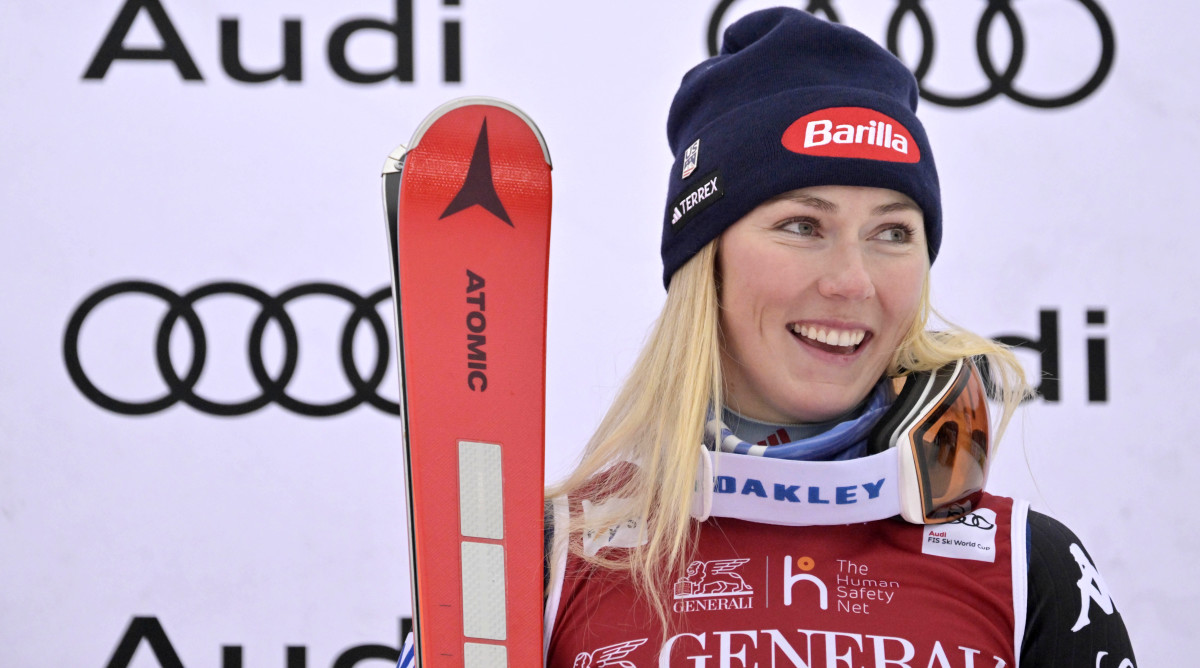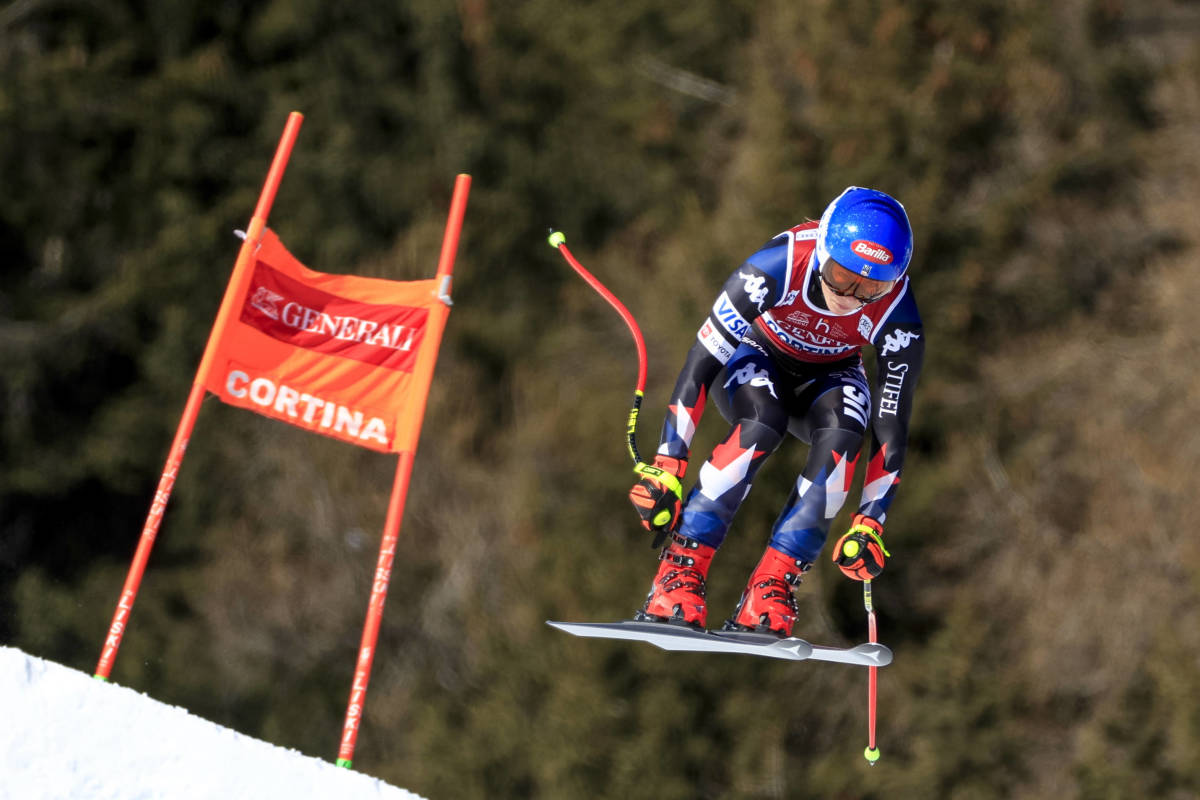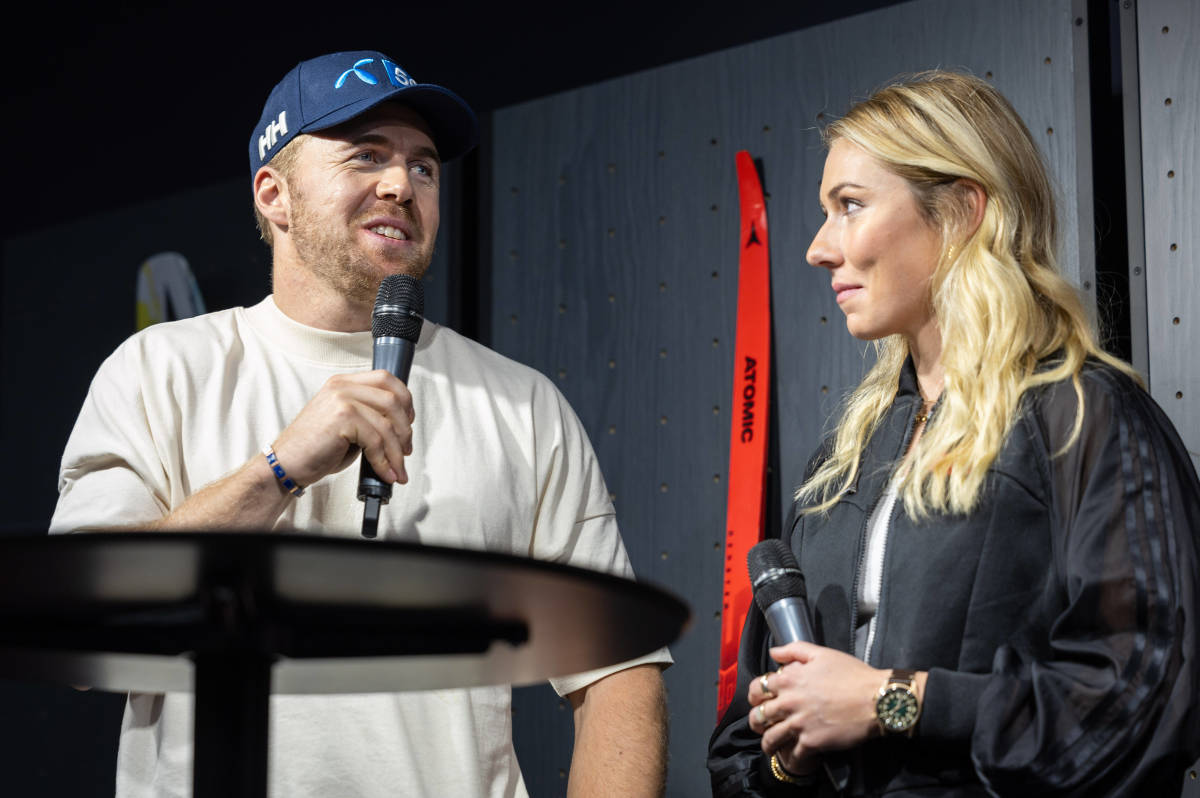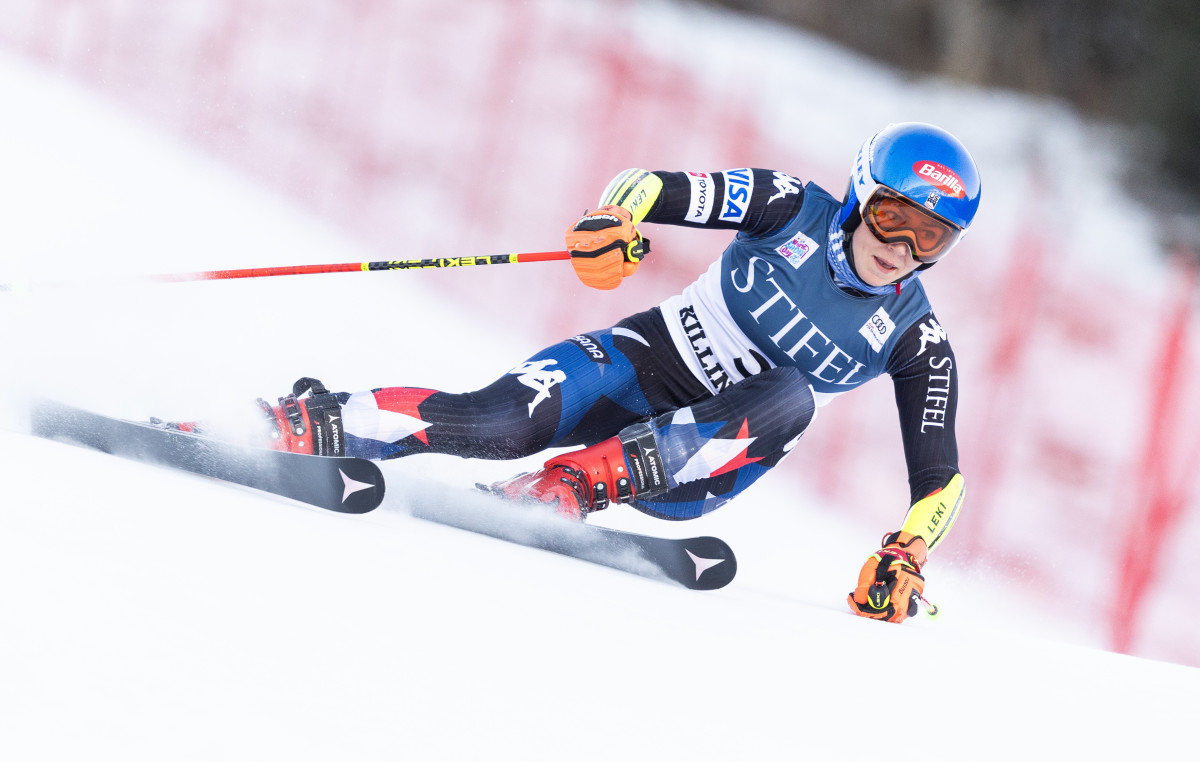Returning From Injury, Mikaela Shiffrin Is Rebuilt Once More

The glow from a laptop screen illuminates the greatest ski racer of all time near the end of another historic World Cup season. Historic, this time, in two ways: for her continued domino-toppling of all records in sight—and for another injury that in all likelihood will cost her any chance at winning another World Championship this season, as she has in four of the last five years.
Mikaela Shiffrin is in Norway, working her way back. Again. She’s not considering her long-term legacy. It’s still far too soon. She’s focused instead on immediate impacts: on the next generation; on her sport, its popularity, its place in wider pantheons of what humans pay attention to and pay to watch; and, now more than ever, what it demands from its top athletes.

The destination—dominance—never changes. Shiffrin wins races within her primary specialty, slalom events, at unprecedented rates. She also nabs speed crowns and combined victories. On March 13, she will turn 29, and yet, she has already won 95 World Cup races, or nine more than the legend, Ingemar Stenmark, who held the previous all-time mark, the one long considered out of reach. She’s not done and doesn’t appear that close to considering retirement. Not yet. Shiffrin, when healthy, continues to ski further and further away from all competition except the only competitor she has left: Mikaela Shiffrin.
She must now be defined in only the loftiest terms. By the best kind of brilliance (often) and spectacular failure (rarely but publicly). By World Cup wizardry and Olympic disappointment. By love, laughter and loss. By injuries and grief. And by deep, personal, public introspection that few, if any, famous athletes would ever dare present to the world.
Shiffrin is all those things. She’s also bunkered down inside a rental cabin in Norway; her room sandwiched between those occupied by her mother, Eileen, and her physical therapist. She describes the space as cozy, meaning wintry and not huge. There are bunk beds in her room and wooden planks overhead and a piano, the one she can’t stop playing. She had booked the cabin in case she could compete. She continues rehabbing her injured knee, healing, making songs.
Shiffrin cannot read sheet music. But she has played the piano since childhood, primarily through sound. Proof that Shiffrin can do pretty much anything lies there. She hears a song, places fingers on keyboards and just plays by ear—everything from Taylor Swift covers to melodies of her own creation. She obviously cannot travel with a piano, and since most hotels don’t have them, any opportunity to soothe anxiety and alleviate pressure and feel human is rare and embraced. There’s one problem in Norway—the piano’s location is in her room. Shiffrin cannot play too late or too loudly. She must play in something like a musical whisper, tapping out chill tunes meant to elicit calm, positive vibes, while not annoying her neighbors.
This is vintage Mikaela Shiffrin, funny and reflective and relatable. Injuries happen. So will more history, as long as she doesn’t focus on her job, winning, or where and how she breaks whatever record she’ll topple next.
Dropping soon: new album, Mikaela Shiffrin’s Recovery Instrumentals.
This weekend, she will also return to the competition where magic tends to happen when she skis. Shiffrin won her first World Cup race in Åre, Sweden, along with her all-time record-tying (No. 86) and breaking (87) races. It’s where she sustained her very first injury—and where she returned to competition after her father died.
Also dropping soon: Mikaela Shiffrin, rebuilt once more, steeled beyond belief and ready, above all, to produce another round of magic.
World Cup victory No. 95 unspooled in Slovakia in January. Shiffrin won that race by the slimmest of margins, 14-hundredths of a second. She climbed onto a medal podium for the 150th time. In a recap email, her reps briefly laid out her plan for the weeks ahead. Head to Cortina d’Ampezzo, Italy; finish training for the upcoming speed series events; and, ideally, cement another overall season championship, good for six total, tied for the most ever.
“I actually remember everything,” Shiffrin says of the day these plans suddenly changed.
The courses that officials set up in Cortina had “a ton of terrain” layered into them. “They built more terrain on purpose,” Shiffrin says. “And the landing zones weren’t completely thought out.” She launches into an explanation of her injury, which is complex and heavy with jargon but centers on ideal lines for racers, how rarely they actually take them and how more terrain meant more racing farther off ideal lines.

While studying that calculus—like which jumps required extreme bends after landing; Daytona Turns, she calls them, because they feel like 180-degree rotations—in one training run, on the part of the course she felt most comfortable with, Shiffrin landed funny. The edge of her left ski “hooked upward,” meaning rolled, as tends to happen when the edge hits first upon landing. Her knee almost buckled. She felt some pain but didn’t hear a pop.
She kept skiing, looking for a place to stop and avoiding gates. But in all the avoiding, her ski hooked upward once more. Shiffrin toppled, only this time toward the fencing on the side of the mountain, which was lined with a safety net.
Because she is Mikaela Shiffrin, she was cognizant of every detail, considering whether the fencing/netting might lead to additional damage and how she might avoid it. Her body tangled with nets. She could tell, immediately. Something was wrong with that left knee. She was stuck under a fence, trying to move but unable to beyond shifting her right hand, face pinned near the ground. Once extricated, she limped off the course with assistance, her left boot elevated above the snow. A helicopter arrived, per protocol, to whisk her to the medical tent.
The subsequent days and weeks ahead brought mostly relief, the kind borne from the good fortune of the injury not being worse. Shiffrin was sore. But she had not torn the ACL or MCL in that knee. She had sprained her MCL, reaggravated a bone bruise from earlier this season and suffered a high-ankle sprain in the same leg, the diagnosis mild in relation to her fears. She had also strained a ligament she didn’t know existed, the one that connects the tibia and fibula at the knee (the tibiofibular ligament). The combination forced her to skip races. She still held a 340-point lead over Lara Gut-Behrami in the overall standings.
She also wasn’t the only competitor who crashed. Nearly a quarter of those who started didn’t finish despite sunny and warm conditions. Shiffrin takes full accountability for her fall, calling it a “driver error” unrelated to the course.
Shiffrin remained as open and vulnerable as any star athlete in sports. She had thoughts but not many that have been ascribed to her in recent weeks. She saw ways her sport could change, modifications that wouldn’t fundamentally alter it but would make it safer, for her and everybody else.
Shiffrin wasn’t the only injured ski star. She had watched her boyfriend, elite racer Aleksander Aamodt Kilde, crash during a downhill race in Switzerland in January. His injuries—dislocated shoulder, torn shoulder ligaments, nerve damage from a calf laceration that required surgery—were severe. She flew there to be with him after surgery. Kilde couldn’t shower, walk by himself or cut up his own food.
They continued to hold the same discussions. Say they had children and, say, one of those children wanted to follow both parents into ski racing. Would it be worth it? Did the rewards outweigh the immense and inherent risks?
She thought so. So did Kilde. But in a sport where danger is baked into the job description, there was the kind that couldn’t be avoided—one person, two skis, up to 95 mph, down a mountain—and the kind that felt less necessary. Another chief competitor, Sofia Goggia, broke her leg in training. U.S. teammates went down, too.
Shiffrin believes that all racers, but especially the most successful among them, are tasked with too many demands. They must arrive at mountains early and stay late, especially if they finish on the podium. Most nights, Shiffrin simply cannot properly recover, eat right and sleep well. There’s not enough time.

She heard tennis star Frances Tiafoe pronounce his sport the most difficult on earth recently. She’d like to debate him, would like him to try ski racing, the sport with more variables than the most complex math equation. Maybe harder. Maybe not. But … different styles of racing. Different tracks. Varied equipment. Travel. Wind, weather, slope, course conditions, time of day, which equipment to use based on everything else. Some races hold evening programs, further jamming up all schedules, which already feature five months of races spread all over the world, with travel and training and recovery packed in between each stop.
“Interesting side note,” Shiffrin says. “I believe we have control over everything in life. Almost everything. We control what we do, how we act, the work we do every day.”
Even then, in a sport where Olympic years equate to interest and sponsorships and attention, she has competed in three Games and won only (per her own ridiculous standard) three medals, two golds and a silver. In 2022, in Beijing, she recorded three Did Not Finish results (DNFs), or just one fewer than in all other races combined over the previous four years.
For Shiffrin, control and dominance never came straight or smooth. She’s not sure what to make of the stretches where she couldn’t ski, whether grieving the sudden death of her father, Jeff, in 2020, or after knee injuries in ’15 or ’23. All happened shortly before the biggest races in her sport, in the parts of its four-year cycle that lack major events.
She’s careful to delineate her thoughts on what could—what should—change. She understands that they will crash. That they will get hurt. She’s not saying that ski racing needs fundamental change, like less challenging courses or smaller mountains to race down. But she’s also not one to buy the easiest explanations for the uptick—staggering, she calls it—in injured ski stars. The one that typically begins, well, it’s risky …
Shiffrin will argue that fatigue factors into injuries near the end of any season. She does argue that it factored into hers. She’d like more communication between top athletes and the International Ski and Snowboard Federation (FIS) officials. Emails she or her reps have sent haven’t always received timely responses. She wants her sport to adopt her team’s motto from the past six weeks: Progress not perfect.
While Shiffrin waited, rehabbed and made up songs on the piano in her Norwegian cabin, she had no choice but to watch her overall points lead slip away. Gut-Behrami trimmed the deficit, then took over the top slot, then extended her lead. By the end of February, Shiffrin remained in second place but trailed by 205 points. Every day, she felt stronger, closer to returning.
Still, weeks spent preparing to ski again rather than actually competing tested her patience and progress. In recent years, especially after she lost her father, Shiffrin redefined what winning meant. She had “failed” at the Olympics. She didn’t disagree with anyone who wanted to label those failures “choking.” But she also got up, came back and openly discussed doubts and mental health and grief, showing the world that elite athletes could be vulnerable and fierce simultaneously. After her last Games, she won the 2022–23 overall World Cup championship by nearly 1,000 points, almost double her closest competitor, Gut-Behrami.
This year, after the crash and multiple Gut-Behrami victories, the math stopped working in Shiffrin’s favor. It became clear that little to no chance of another championship—winners are awarded Crystal Globes in each discipline and overall—remained. She wanted to push forward, anyway. But Shiffrin knew better, knew she had to stay in process, heal, returning only when ready. She says she rarely races anywhere near 100% in terms of physical, mental and emotional wellbeing, along with fitness, health and readiness. She can win races at 50% of that calculus in slalom events. But in the speed versions, she must feel much closer to 100 in order to feel safe competing. Races she decided to skip in Italy were canceled, as were others in Germany she wouldn’t have competed in. All cancellations owed to heavy snowfall, which only reinforced her point. In the sport of a million variables, the very weather that makes a course ensured Gut-Behrami could not extend her points lead.

Shiffrin could go full Dumb and Dumber at that point. So you’re saying there’s a chance!
She’ll start with the return, her latest if progress holds, in Åre, Sweden, on March 9–10. She’ll thank her physical therapist. She’ll continue to watch her younger U.S. teammates, fellow competitors with whom she set out to create more of a team or community years back, as they do exactly what she hoped—ski faster, win races, make every slice of history she earns moving forward that much more difficult to obtain.
It can be strange, watching competitors zip down mountains, each slightly faster for the dominance Shiffrin has long displayed, for the standards she raised and the attention she culled. She’s proud of that. She also still wants to beat them. “Everybody wants to retire on top,” she says. “But if you push the sport hard enough, there’s a chance you can’t. I push. People catch up. I push. People catch up. They surpass. I push. I catch up. I surpass.” Earlier in her career, competitors mostly did the catching up. Now, she says it’s more like they leapfrog each other. Now, she’s the one being pushed.
Shiffrin’s not ready to consider legacy. Not in an overall sense, anyway. She wasn’t ready at 17 when journalists asked how she wanted to be remembered. She’s not now, at almost 29, when she plans to win more races, championships, trophies and medals.
She hopes that getting up, always—coming back, always—is part of whatever her legacy will be. She hopes that pushing the sport and her competitors is added to that equation. Built to rebuild and rebuilding once more. That’s Shiffrin, a competitor who hardly needs to consider her legacy, because what she has done—and how she did it—speaks for itself.
